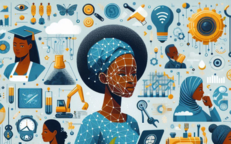Doctors without Borders: Can Telemedicine help Africans access proper healthcare?

Authors: APET Secretariat
This post is the 8th in a blog series published in 2020 by the Secretariat on behalf of the AU High Level Panel on Emerging Technologies (APET) and the Calestous Juma Executive Dialogues (CJED).
The utilization of information and communication technologies (ICT) as a tool to improve the efficiency of healthcare service delivery is increasingly being considered in Africa. Applications such as telemedicine, tele-education, and health informatics are fast becoming part of essential services and considerations towards their utmost assimilation in Africa’s infrastructural systems needs to be considered.
Understandably, the COVID-19 pandemic has necessitated the need for African countries to explore harnessing emerging technologies to connect patients with qualified and easily accessible healthcare practitioners, without necessarily being in physical contact. It is reported that during the COVID-19 pandemic, nearly 7,000 frontline healthcare workers lost their lives due to infections emanating from infected patients.[1] Furthermore, the continent has limited doctors per thousand inhabitants[2] due to limited human capital and resources across the continent. For example, it was reported that given the different mix of health worker cadres (doctors, nurses, and midwives), most African countries had a uniquely low average of 1.3 health workers per 1,000 people as of 2012 (see Figure 1).[3] This was typical across African countries with respect to the different health systems available around the continent. Unfortunately, this barely compared to the average of 12.5 per 1,000 and 15.2 per 1,000 people in the United States of America and Sweden, respectively. With such continental limitations, harnessing innovations such as telemedicine can enable efficient digital communication and sharing of medical information between healthcare workers and their respective patients.
Telemedicine becomes very useful in cases of pandemics such as COVID-19, H1N1, and Ebola, as telemedicine consultations can prevent infection of healthcare workers through physical contact with infectious and carrier patients of such diseases. To achieve this, telemedicine involves a network of service providers who work with remote clinics through information and digital technologies to connect patients with healthcare workers. In this way, telemedicine provides access to tailored-made and on-demand healthcare services with mutual financial benefits to both the service providers and the patients.

Significantly, the role of telemedicine became more apparent and vital during the COVID-19 pandemic when people were restricted to freely move about because of lockdowns imposed by numerous countries globally. Consequently, medical consultations were executed through telemedicine in some countries and there was an incremental use of medical information from digital libraries. Remote access to healthcare services increased the level of service delivery to disadvantaged and vulnerable communities across the world.
Thankfully, Africa is catching up on telemedicine services, as in some parts of the continent. For instance, the ECHO Clinics model being developed across the world is being replicated in African countries such as South Africa, Malawi and Kenya; a form of advanced telemedicine. Such a model democratizes medical knowledge through intersecting experts and conveners on one hand and beneficiaries on the other hand.
Notably, such expansions of telemedicine were organically increasing because of the pandemic, across the continent. There was limited participation and involvement of Africa’s policymakers however in this expansion, as this was more private-sector-driven. Therefore, it becomes necessary that policy and regulatory frameworks are enacted by policymakers and decision-makers in collaboration with all stakeholders towards effectively utilizing telemedicine. To speed up the domestication of telemedicine as process innovation, it remains crucial to pay attention to regulatory framework considerations at national, regional, and continental levels across the continent. Policymakers are additionally encouraged to adequately address the challenges related to human skills capacity, unreliable energy, ethical, privacy, and policy challenges that telemedicine may potentially pose to Africans.
Investments in ICT has become necessary to advance digital technologies such as telemedicine in Africa’s healthcare systems to enable rural Africa to acquire adequate internet and broadband coverage and access. Efficient and reliable ICT, internet and broadband infrastructure can significantly enhance the dynamic digital technology environment in Africa and ease the adoption and adaptation of the 4th Industrial Revolution technologies for the African citizenry.
In conclusion, telemedicine can be utilised as a mechanism that can allow for efficiently promoting access to healthcare for all Africans, irrespective of their geographical location. Telemedicine is the future of medicine and is worth harnessing by Africa.
Featured Bloggers – APET Secretariat
Justina Dugbazah
Lukovi Seke
Barbara Glover
Bhekani Mbuli
Chifundo Kungade
[1] Over 7,000 health frontliners dead from Covid-19 (Agence France Press edition of September 4, 2020) https://www.nst.com.my/world/world/2020/09/621811/over-7000-health-frontliners-dead-covid-19.
[2] World Health Organization's Global Health Workforce Statistics, OECD, supplemented by country data: http://data.worldbank.org/data-catalog/world-development-indicators.
[3] John Ashmore, Dual practice, and the availability of medical specialists in the public and private sector of South Africa, University of Cape Town, Health Economics Unit, School of Public Health and Family Medicine, South Africa.


